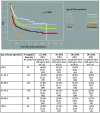60 Days in Biliary Atresia: A Historical Dogma Challenged
- PMID: 32140208
- PMCID: PMC7050960
- DOI: 10.1002/cld.843
60 Days in Biliary Atresia: A Historical Dogma Challenged
Figures




References
-
- Arnon R, Annunziato RA, D’Amelio G, et al. Liver transplantation for biliary atresia: Is there a difference in outcome for infants? J Pediatr Gastroenterol Nutr 2016;62:220‐225. - PubMed
-
- Reuben A. The sensei of Sendai: Correcting the uncorrectable. Hepatology 2003;37:952‐955. - PubMed
-
- Kasai M. Results of surgey for biliary atresia In: Javitt NB, ed. Neonatal Hepatitis and Biliary Atresia. Washington, DC: US Government Printing Office; 1977:417‐433.
-
- Mowat AP. Liver disorders in childhood. Oxford: Butterworth; 1980.
-
- Brumbaugh D, Mack C. Conjugated hyperbilirubinemia in children. Pediatr Rev 2012;33:291‐302. - PubMed
Publication types
LinkOut - more resources
Full Text Sources

